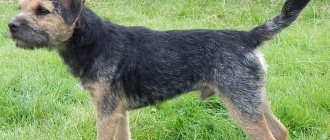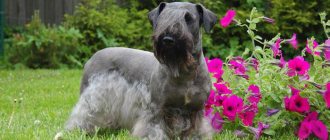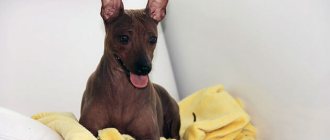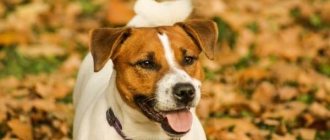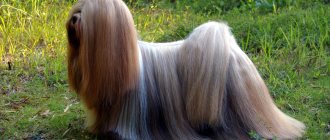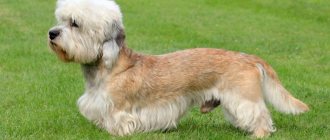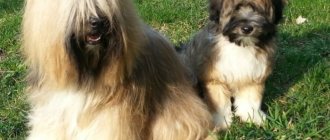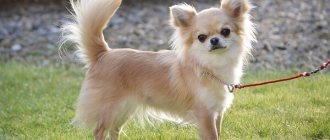Brief description of the breed
What is the actual country of origin?
Great Britain
What is the country of origin according to the FCI?
Great Britain
When did the breed appear?
year 2001
How long does he live?
from 13 to 15 years
How much does a male dog weigh?
from 7 to 9 kg
How much does the bitch weigh?
from 6 to 8 kg
What is the height (height at withers) of a male dog?
from 33 to 37 cm
What is the height (height at withers) of the bitch?
from 31 to 35 cm
How much does a puppy with documents cost?
from 20 to 50 thousand rubles
What is the price of a puppy without documents?
from 50 to 20 thousand rubles
Parson Russell Terrier is a breed of hunting dogs that are relatives of Jack Russell Terriers. Breeders and owners of these dogs characterize them as gentle, brave, purposeful rodent hunters. Animals are distinguished by activity, endurance, and speed. They are very loyal and will fit perfectly into a family with children.
Description
Due to common ancestors, the Parson Russell Terrier is very similar to the Jack Russell, which is clearly visible in the photo. The first for a long time did not have their own standard of appearance, but there are still differences in appearance, and in our time they are even recognized by dog handlers all over the world. Parsons are distinguished by their tall stature, square body, long, elongated legs; Jacks, on the contrary, look stockier and smaller in stature.
Representatives of the described breed have a flat and wide skull, gradually tapering towards the muzzle. The transition is smooth and small. The jaws are well developed and strong, and the bite is scissor-shaped. The nose is always black. Almond-shaped eyes are characterized by a deep set, dark iris. The dog looks attentively and inquisitively.
Small, forward-hanging ears are shaped like a perfect triangle. Their ends reach the corners of the eyes. In a purebred dog, the neck is muscular and gradually widens towards the shoulders. The standard does not provide for a massive neck. The body is distinguished by its squareness, strong back, slightly convex loin, and sufficient chest depth, which is located at shoulder level.
Video
* We invite you to watch a video about the Parson Russell Terrier . In fact, in front of you is a playlist in which you can select and watch any of 20 videos about a given dog breed by simply clicking on the button in the upper right corner of the window. In addition, the material contains quite a lot of photos. By looking at them you can find out what a Parson Russell Terrier looks like.
In this article:
|
Rate the material!
[Total votes: 1 Average: 5]
Choosing a puppy
Before going to the breeder, you need to establish for what purpose the pet will be used. A future exhibitor or hunter should look for appropriate dog breeders. Moreover, active puppies are suitable for hunting, with pressure and effort to grab their brother or sister by the belly; it is better to choose a calm baby as a pet. Parsons are very similar to Jack Russells when they are babies. To make sure that the breeder is not deceiving, you should go to buy 8-9 month old babies.
The offspring should not be too spotted: white should exceed half the color of the entire body. Also, the puppy must move confidently, without lameness, head tremors or trembling - otherwise the dog is unhealthy. The parents do not have to belong to the same litter, so it is worth studying their pedigree.
The cost of the Parson Russell Terrier is as follows:
| approximate cost | |
| No pedigree | From 15,000 rub. |
| For breeding work | 20,000 – 25,000 rub. |
| To participate in shows | 30,000 – 40,000 rub. |
History of the origin of Parson Russell Terriers
The breed received its modern name only in 1997 in the UK. Before this, Parsons were classified as Jack Russell Terriers. By 2008, dog breeding organizations from around the world officially changed the name of the breed. The history of these animals begins with the priest Jack Russell from Devon, who was a passionate fan of hunting.
In 1819, a vicar purchased a small white and brown dog and named it Trump. It is this female terrier who is the founder of the Parson Russell Terrier family. The priest set out to breed a breed that would have excellent hunting skills for small game, a large supply of energy and a love of adventure.
At the same time, the pets had to develop high speed and be resilient in order to keep up with the horse. And the priest succeeded perfectly. The breeder made a lot of attempts at inbreeding between solid and motley terriers. For him, hunting qualities came first; uniformity in litters was not taken into account.
For the monk, the animal’s courage was important, so that the dog would rush into the fox’s hole for prey without hesitation. By experimenting with fighting breeds, the pastor achieved such characteristics as fearlessness and a strong grip. Church officials were dissatisfied with the priest’s hobby, so they did not give him a title higher than vicar. However, his legacy still brought fame to the minister.
Later, Russell tried to crossbreed his pets with other breeds, but the resulting individuals did not meet the needs of the hunter. Due to unsatisfactory results, work in these directions did not continue. After the end of World War II, dogs gained popularity among hunters on the European continent.
The British Kennel Club recognized the breed on January 22, 1990 as a variety of Fox Terrier. The club rejected the first application, submitted in 1983. The Fédération Cynologique Internationale added the breed to its temporary list on July 2, 1990. Parsons were recognized along with other breeds on June 4, 2001.
Origin story
The name of the dog breed was given in honor of Pastor John Russell. He devoted his entire life to spiritual religion, but, like all men, he loved to hunt, and for this he needed a smart, fast dog that would have high intelligence and would not spoil its fur while hunting an animal.
Parson Russell Terrier
While still a student, John went to a local farmer to choose a puppy. Selection Criteria: Long-legged, highly intelligent and with an understanding of basic commands.
Very soon, John bred several puppies, the breed of which he named in his honor. Many hunters immediately became interested in these dogs, and dog handlers began improving the breed. Mating a terrier with a Sealyham terrier endowed the animal with intelligence and the ability to follow commands well.
Interesting fact! Since 2001, two breeds have been developed: the Jack Russell Terrier with short legs and the Parson Russell Terrier with long legs. At the same time, the Jack Parson Terrier and Parson Larsen Terrier breeds do not exist - people use such names out of ignorance. The name Jack Parsons is also a misnomer.
Parson Russell Terrier - description of the breed
In the appearance of dogs, slight deviations from the standard may be allowed, since working qualities come first and are taken into account more than the exterior. In general, the animals are small in size, have a balanced, lean build, a square body with pronounced muscles.
The skull is of medium width, gradually tapering towards the eyes. Cheekbones are practically not visible. The nose is wide, the lobe is large, dark, the nostrils are open. The transition from forehead to muzzle is practically absent. The jaws are powerful. Adults have 42 triangular teeth. The bite is correct, scissor-shaped. Babies have 28 baby teeth.
The lips are black, dry, and fit tightly to the teeth. The eyes are almond-shaped, small, deep-set. Dark colored iris. The ears are of medium size, the skin is of moderate thickness, triangular in shape. The lower end reaches the outer corner of the eye. The free part of the ear hangs forward. The cheeks do not protrude.
The neck is of medium length, muscular, gradually widening towards the shoulders. Covered with thick skin without folds, muscular. The back is strong and straight. The loin is strong and slightly sloping towards the tail. The chest is shallow and does not fall below the elbow line. According to the standard, it should be grasped at the level of the shoulder blades with palms of average size.
The ribs do not protrude, but they should not be flat. Movable, which allows the dog to easily slip into the hole. The abdomen is tucked up, without dewlap. Since this is a burrowing dog, its proportions must be balanced. Limbs are strong and straight. Arranged in parallel. There is no standard for weight.
Ideal parameters for Parson Russell Terriers:
- The height of males at the withers is 35.5 (±2) cm;
- The height of the bitches at the withers is 33 (±2) cm.
The tail had always been docked previously. Now this is an optional procedure. Docked set on high, strong, straight. When in motion it is raised up, when at rest it is lowered. Undocked - medium length, usually straight. Wide at the base, tapering towards the end. High rise. When in motion it is raised up, when at rest it is lowered.
Breed history and appearance
Parson Russell has been known as a breed since the beginning of the century before last, but such terriers received official international recognition only in 2001. An English pastor of the 19th century, with the surname Russell, tried to breed a terrier for fox hunting - and so that the dog would not only confidently run next to the rider, but also not spoil the skin of the prey. The British loved to hunt, so the breed became quite widespread, primarily due to the dog’s assertiveness, speed and activity.
In 2001, standards were established and two types of such terriers were identified - the Parson Russell itself and the short-legged Jack Russell, reaching a height of 33 cm at the withers. Parson, in turn, could reach 37 cm.
Dogs' names are often shortened to PRT or PJT, so don't be surprised when you see this abbreviation
Outwardly, these dogs look like a small, wire-haired dog with a black and white or red and white color. The animal is proportionally built, the tail is of medium length, like other terriers. The dog's ears are v-shaped, hanging forward, which gives the dog a funny expression. Children really like the appearance.
Popular colors of Parson Russell Terriers
The skin is dense, the coat is coarse, and the undercoat is thick.
There are three types of coat:
- Coarse long hairs. The face has eyebrows, mustache, and beard. Regular trimming is required;
- The coat is of moderate length, lying close to the body. Trimming is also required;
- Short hair.
The coat of all types is straight, bristly, and protects well from getting wet in bad weather. The entire body, including the inner thighs and belly, should be covered with hair. The final type of hair is formed only by the second month of the puppies’ life; this should be taken into account when purchasing. The fluff that appears in the first month of life indicates the wire-haired type.
The long-haired type has a hard pile that does not fit tightly to the body. Because of this, the dogs look quite shaggy. The hair is not very rough to the touch. Intermediate type dogs do not grow eyebrows or a beard. The hair is broken in some places. They fit snugly to the body and do not stick out in different directions.
The smooth-haired type has short hair that lies very close to the skin. They are best suited for hunting, since short hair does not prevent dogs from crawling into narrow holes and getting game from there. Together with the dense undercoat, the hair coat provides excellent protection from bad weather conditions. Thin and soft wool is considered a defect.
The breed cannot boast of a variety of colors.
The following colors exist:
- White with tan (black and brown spots);
- Solid white.
The basis of the color is white. There may be spots on the back, tail and face. White and black, combined with any other shade, is called tricolor. Brindle coloring and spotting covering more than 50% of the body are unacceptable.
Breed types and standards
The FCI classifies the Parson Russell Terrier as a dog of medium height. The person is approximately knee-length. Males reach 36 centimeters at the withers, and females reach 33 centimeters. The pet's weight will not exceed 10 kilograms. Usually it is 7-8 kilos.
The Parson Russell Terrier standards prescribe several important proportions of the dog's body. So the length of the muzzle from the nose to the forehead is slightly shorter than from the stop to the occipital protuberance.
Stop is the very line between the muzzle and the forehead. In the body of a Parson, the length of the withers is slightly shorter. We compare it from the back to the tail. The terrier's latter is straight, strong and set high. The tail above the back creates a cheerful image of the dog.
Everything about the Parson Russell Terrier is balanced and moderate. The chest does not fall below the elbow line. The croup is without bends, and the loin is slightly convex. The dogs' legs are straight and muscular with equally straight elbows. Their reversal is unacceptable. The position of the shoulder blades is also important. They are inclined, extended back.
This gives the terrier's body a streamlined appearance. The shoulder blades do not stand out above the withers, which means they do not interfere with climbing into holes. For the same purpose, dogs with flexible kneecaps of the hind legs were selected.
The Parson Terrier's neck should widen slightly towards the withers. On the neck is a head with almond-shaped and deep-set eyes. They're dark, they seem shrewd
The edges of triangular ears, pressed to the head, fit the corners of the eyes. Their stance is inappropriate, because when hunting, your ear can get caught on a branch, and a wild animal can grab it.
Parsen Russell Terriers into , nor are dogs with underbites or overbites. The standard states that the teeth of hunting dogs must meet evenly.
The bite is scissor-shaped, complemented by powerful jaws with lips tightly fitting to them. This allows you to make a death grip, catching burrowing animals, without damaging the dangling snouts in a fight. The nose of Parson Russell Terriers is always black, but the coat is light. The entire dog can be white, but markings are also allowed.
Typically, colored spots are located on the head and tail. The standard provides lemon, black, red inclusions. One of them, or all of them at once, may be present on a white background.
Parson Terriers have no subspecies. Previously, the Jack Russell was considered a variety, but is now separated into a separate breed. By the way, the dog didn’t end up in “Mask” by accident. The breed is popular in Europe and America, which cannot be said about Russia.
Character and habits of Parson Russell Terriers
Animals have a curious character, energy, and love adventure. They love walks in different places and do not tolerate monotonous training. They are restless, explore the area, are interested in the smells and sounds around them, and get to know people with interest.
These dogs love to travel, making them great companions for adventure lovers. Despite the fact that the original purpose of four-legged animals was hunting, in our time dogs are practically not used for these purposes, only as pets.
The creatures are very fond of games and pranks. They quickly become attached to the family and do not tolerate being alone in the apartment for a long time. Excessive fearlessness can be a disservice to the dog. In urban conditions, animals can provoke other dogs, even those significantly larger than their size, to fight.
Owners by nature, four-legged animals require a personal, isolated space in which their sleeping place and individual toys will be located. Because of his love for digging holes, the Parson should be taken out of town and taken to the park. Otherwise, all the pet’s unspent energy will go into damaging household property.
Four-legged animals get along well with children. But how they will get along with other pets is unknown. Perhaps they will become friends, but there is also a possibility that there will be constant squabbles at home. To prevent a dog from showing aggression towards its relatives, constant control over it is needed.
High intelligence allows Parsons to make independent decisions. In addition to charm and playfulness, dogs have qualities inherent in all terriers: a tendency to run away, willfulness, restlessness, adventurism, a desire for pranks, obsession, and cockiness.
Animals are highly trainable, but some qualities prevent them from becoming first-class athletes. Eccentricity and independence sometimes lead to disobedience. If a dog feels needed and cared for by its owner, it will do everything to make the family in which it lives happy.
Description and features of the Parson Russell Terrier
The Parson Russell Terrier in the photo is a short dog with a slightly disheveled appearance. It is associated with coarse hair sticking out in all directions. Dogs with it were specially selected.
Soft hair clung to bushes, grass, and became entangled in reeds. Coarse and short hair does not interfere with overcoming obstacles on the way to game. Parson Russell Terriers were originally bred as hunting dogs, with an emphasis on hunting badgers and foxes.
Both animals are aggressive and know how to fight back, scaring most dogs. The fearlessness, agility and tenacity of Russells are nonsense even among hunting dogs. The name of the breed is given by the name of an English pastor who became interested in breeding dogs. The priest was also interested in hunting. Having bought an ordinary terrier in 1819, he began to breed an ideal type of hunter from his point of view.
The breed was officially recognized only at the end of the 20th century. It was divided into Jack Russell and Parsen Russell in 2001. It is not surprising that the character of the Parson Terrier is not inferior to the perky disposition of the Jack. Remember that in the movie “The Mask” the dog relentlessly follows its owner?
It’s the same in life. Parsen Russell Terrier puppies , like adult dogs, do not tolerate loneliness. Attractive companionship can backfire. Russell Terriers, for example, are risky to leave alone at home.
Out of loneliness, a pet can go to great lengths, causing a pogrom in the apartment. At the same time, other pets do not suit the terrier as companions. Relationships with other animals are strained.
What the Russells need is a human collective. In this regard, the dog is suitable for families with children. Kids are ready to give Russells irrepressible attention, for which the pets pay with fun games and affection.
The build of the Parson Russell Terrier is dry and wiry. Representatives of the breed have well-developed hock joints. The hero of the article takes advantage of this. The Parson Russell Terrier is jumping and can run and jump without stopping. At the same time, the dog is not lying. Silence has been established since the 19th century.
Pastor John Russell understood that there were many dogs present in horse hunts. If they start barking for no reason, all the game will run away. Therefore, when breeding a Parson Russell Terrier, the priest selected puppies that were calm in terms of speech.
Interesting facts about Parson Russell Terriers
International Breed Day is celebrated on July 2. It was on this day in 1999 that the World Canine Federation officially recognized her. Dog owners and simply lovers of the breed get together, celebrate, and organize competitions between their pets.
These animals are considered the best high jumpers. To date, the Guinness Book of Records has registered a jump of 198 centimeters. The breed is also in the top ten among long-distance runners. Jack Russell was a lover of horse riding and instilled in dogs the ability to tirelessly run after a horse for a long time.
If four-legged dogs are raised in a single-owner household, they will be incredibly selfish. Creatures living with one owner consider themselves the center of the universe and try in every possible way to fill all the owner’s free time. Jealousy can cause them to growl, get angry, or express dissatisfaction in other ways.
Many people confuse Jack Russell Terriers and Parsons. Their most important difference is the height at the withers. If the former reach 30 centimeters in height, then the latter grow up to 36 centimeters. The second difference is the square parson format. Jack Russell Terriers have a longer build.
Dogs are often used to treat depressed people or people with disabilities. Pets will help cope with a bad mood and give the owner a lot of joy and fun. Four-legged animals are used in canistherapy, help improve the abilities of children with cerebral palsy, autism, and turn a withdrawn child into a sociable one.
During his lifetime, the creator of the breed was considered a madman, and his charges were considered defective. The dogs allegedly did not meet hunting standards. However, the animals quickly gained popularity among hunting enthusiasts, thereby proving that the pastor was able to achieve incredible success in his work. The breeder sold his pets many times, keeping only Trump, the first dog.
Raising and training the Parson Russell Terrier
Although the Parson Russell Terrier is a whirlwind of happiness and fun, first and foremost it is a hunting dog. Remember, Reverend Russell created a hunter while neglecting other qualities. The dog's hunting instincts are so strong that it will be very difficult for a novice dog breeder to cope with a fidget, and sometimes even impossible. Therefore, it is recommended that dogs of this breed be sent to dog handlers for training . This way you will save your nerves and time and get an obedient dog.
Pros and cons of Parson Russell Terriers
Dogs are very loving. Therefore, they are not suitable for owners who spend a lot of time outside the home. Animals can play too much due to their nature and accidentally push a small child. But the four-legged animals are strong friends with older children. Excessive energy can be a hindrance for older people.
However, for young people who are fond of sports and lead an active lifestyle, who have sufficient time for their pet, the creatures will become wonderful companions. They quickly get used to any living conditions. They happily accept the owner’s various ideas and always support him in his desire to go on a trip.
The creatures are unpretentious in care; wire-haired individuals do not shed. However, they require serious education. A craving for pranks without training can result in chewed shoes, scratched wallpaper and furniture. Without education, dogs' uncontrollable emotions develop into aggression and anger.
Thanks to its good security qualities, you will always be alerted to possible danger. The creatures will rush to defend their owner without hesitation, even if the attacker is large. If the dog does not feel threatened by a stranger, he will treat the stranger calmly. Loyal creatures will give love to their owner until the end of their days.
The Parsons have a good sense of human mood and do not skimp on reciprocity: they respond to love with love, to hate with hatred. Raising a best friend from a dog is not difficult. The main thing is to give him care, warmth, treat him like a family member, accept all his advantages and disadvantages.
Pros and cons of the breed
The Parson Russell Terrier breed is completely unsuitable for older people with disabilities, as well as for those who are very busy at work and cannot devote enough time to their dog.
The best option for owners for PRT is a family with children, where each member of the household can take care of the pet and pay attention to it.
Familiarize yourself with the main pros and cons of the Parson Russell Terrier breed, this will make it easier to determine whether this breed is right for you or not.
Advantages:
1. Friendly disposition. 2. Suitable for apartment living, subject to daily walks. 3. Intelligence and intelligence. 4. The hunting instinct is well developed. 5. Gets along with children. 6. Good health, strong immunity. 7. Quickly gets used to any conditions.
Breeding Parson Russell Terriers
Before buying a dog, you should immediately decide whether it will be used for breeding. If you have no plans to reproduce offspring, it is better to castrate the male immediately, and sterilize the female. These actions will help the animals maintain a balanced character.
Males with O and females with a rating of “very good” are allowed for breeding. Before mating, you must show your pet to an expert at an exhibition. It happens that the descendants of titled parents are not valued highly and are not allowed to breed.
If you decide to start breeding yourself, keep in mind that animals reach puberty at 1 year. However, the full development of the body occurs at the age of two, so the first mating is best done at 2 years of age during estrus, which lasts about two weeks.
If a bitch is brought to an unfamiliar dog, most often she behaves aggressively and growls. The manual method of mating is practiced, in which the dogs are kept on leashes. Experienced males, regularly used for reproduction, do not pay attention to their partner’s aggression. Control mating is carried out after 1 day to predict the ovulation period.
Pregnancy in Parsons lasts about 60 days. However, the first signs of its onset become visible only after a month.
These include:
- Swelling of the nipples - appears at 3 weeks of pregnancy;
- Increased volume in the ribs - in a sitting position, the female looks plump;
- Changes in behavior - loss of appetite, calmness, apathy.
Childbirth in females of this breed is easy and the help of a veterinarian is often not required. With the onset of labor, the wall of the uterus becomes hard and does not allow the droppings to be felt. Usually 4-6 babies are born. Until the end of the birth, it is better to place the puppies separately in a soft cloth. Then place it on the mother's nipple.
Dog nicknames: names for Parson Russell Terriers
Most people prefer to choose a short, sonorous name for their dog.
You will have to say your dog's name many times a day, and if it is too long, it will be tiring.
When choosing what to name your Parson Russell Terrier, you can follow two methods.
- The first and easiest: open the list of the most suitable names for this breed and choose the one that you like best .
- Second: choose an unusual name from other sources, for example, from mythology or literature, name the dog after your favorite celebrity , or come up with your own exclusive name .
There are many suitable names for Parson Russell Terriers girls:
- Abby,
- Dalia,
- Lara,
- poppies,
- Mary,
- Selena,
- Tara,
- Flo,
- Vanilla,
- Daisy,
- Toffee,
- Nyura,
- Teens.
The following names are good for Parson Russell Terrier boys:
- Wil,
- Gail,
- Devin,
- Leslie,
- Lloyd,
- Austin,
- Jack,
- Camelot,
- Singer,
- North,
- Rolex,
- Ford,
- Reference.
Caring for Parson Russell Terriers
Grooming for dogs of this breed is minimal. The hard coat has virtually no odor and does not shed. You can brush it once a week with a stiff brush. White individuals also do not need frequent bathing. Fur has a unique ability to self-clean, so they should only be washed as a last resort. Bitches are bathed after estrus.
Ears and teeth require regular cleaning. Once a week, the animal’s teeth are brushed with a special brush, and the auricle is carefully cleaned with a damp ear stick. Claws are trimmed as they grow. If your pet often walks on asphalt, this procedure may not be performed. Deposits from the eyes should be removed with a cotton swab dipped in warm water.
The ideal living conditions for a parson would be a fenced-off area in a private house. In winter, the animal is moved indoors. A chain or enclosure is not suitable for keeping. The dog needs the opportunity to go out into the yard at any moment. However, even in urban conditions, four-legged animals feel comfortable.
Periodic trimming of animals with long and medium hair will rid the room of hair and give the pet a well-groomed appearance. To live in an apartment, the dog will need at least 2 hours of walks with active games and training. Creatures show curiosity even in a one-room apartment. It’s worth taking this into account and hiding valuables from them.
After purchasing a puppy, you must immediately begin training. Although even an adult terrier is capable of mastering the necessary set of commands. The hunting breed has a good memory and intelligence, so it quickly grasps the rules of behavior. If you want to develop special skills, it is better to seek help from a specialist.
Nutrition and care of the breed
Like other dogs and people, Parson Terriers need proteins, carbohydrates and fats. Their proportions are important. Meat accounts for 40-50% of the diet. They need to include offal, that is, kidneys, stomachs, liver, necks of chickens. Common meats include horse meat, beef, rabbit, and turkey. Once a week, boneless white fish and one chicken egg are healthy.
Parson Russell Terriers need minimal fat. Therefore, pork and lamb are excluded from the diet. Enough fat from other products, in particular cottage cheese. It is recommended for representatives of the breed.
The source of carbohydrates for the hero of the article is oatmeal, rice and buckwheat. Barley and pearl barley are contraindicated. Semolina can be given, but it does not contain a supply of useful substances, it only saturates.
Vegetables in the Parson Terrier's diet account for 5-10% of products. Pumpkin, carrots, zucchini, dill, and bell pepper are good for dogs. If you rely on dry food, it is important to pay attention to the consistency of its composition with the natural diet of your four-legged friend.
In America to buy a Parson Russell Terrier because they have the conditions to keep it. An active and energetic dog requires at least 2 hours of walks every day. In private buildings in the United States, most have adjacent areas where dogs frolic.
It is more difficult to keep a Parson Terrier in an apartment. A dog for those who have free time. It’s not enough to take a walk, you need to play and socialize. Otherwise, the animal begins to cause mischief. This is a sign of protest and a call to pay attention to the dog.
Other care for representatives of the breed is simple. We comb the dog once every 7 days, wipe the ears with a disinfectant solution, and trim the nails once a month. We brush teeth with toothpaste for dogs. It is sold in pet stores. All that remains is to figure out where to get them and how much.
Diet of Parson Russell Terriers
Every dog owner faces the choice between ready-made food and natural food. And the owner of the parson will have to do it too. One and the second type of nutrition have their pros and cons. Although the creatures are not susceptible to allergic reactions, preference should be given to expensive premium food that does not contain preservatives or dyes.
Since the creatures are excessively active, the calorie content should be high or at least medium. Natural food is healthier than prepared food, but it requires a time investment. The owner must independently create a diet, buy and prepare food.
A pet accustomed to dry food and canned food receives all the necessary microelements. This is very convenient for busy owners. When feeding naturally, it is better to prepare a menu for the whole week at once in order to provide your pet with all the nutrients.
The main part of the diet should be meat. Chicken, lamb, and lean beef are doused with boiling water, but not boiled. Meat should make up at least 40% of the menu. You can supplement your diet with rice, oatmeal, and buckwheat porridge. They are boiled in water because broths do not provide any nutritional benefit to dogs.
Vegetables in the diet should include pumpkin, carrots, zucchini, beets, and greens. Sea fish can be given once a week, as well as offal. Once every 3 days, dogs are offered eggs and fermented milk products. Vitamin supplements should be chosen as recommended by your veterinarian. Despite good digestion, terriers are unable to digest bones.
The following should be strictly prohibited:
- Pork;
- Sweets;
- Flour products;
- Potato;
- Legumes;
- Allergens in the form of nuts, garlic, milk, honey.
Care and maintenance
The Parson Russell Terrier is well suited for living in an apartment, but if you live in a private house, then no matter what happens, it is not advisable to put him on a chain in a kennel on the street. In Russia, he can freeze and die from hypothermia:
- If you have a smooth-haired pet, then you need to thoroughly comb it once a week. Wire-haired cats need trimming once every six months.
- You need to wash your dog and clean his ears when he gets dirty.
- Wipe sour eyes with a cotton pad with black or chamomile tea (you can also purchase a special product).
- Teeth should be brushed with a brush and toothpaste designed for dogs two to three times a week.
- Trim overgrown claws.
Read Poodle - circus performer and cheerful friend
Nutrition
The Parson Russell Terrier's diet consists of meat and offal. Turkey, rabbit, beef, chicken - will be very useful for the dog. But you also need to add variety to the terrier’s diet, for example, boneless fish and chicken eggs. Since the Russell is a very dynamic breed, his diet requires proteins, but carbohydrates are also important - the dog eats rice, oatmeal and game. It is better not to overdo it with fats. Similarly, it is possible to accustom a terrier to some extent to dry food.
Possible diseases
Dogs of this breed are distinguished by good health: they rarely get sick with hereditary diseases. If there are diseases, they are mostly infectious. This mainly happens due to tick and flea bites. Before walks in the summer, you should treat your pet’s fur with special products, and after a walk, comb and carefully examine the dog.
Breeding and mating
Dogs of medium and small breeds, unlike large breeds, mature earlier. A one-year-old male terrier is already ready to procreate, and the female is already going through her first heat stage. Bitches come into heat once or twice a year, with the first heat occurring between 6 and 12 months of age. Duration ranges from 21 days to one month.
Signs of heat:
- frequent urination;
- swelling of the external genitalia and bleeding;
- change in appetite;
- molt.
The onset of heat can be seen during a walk; the dog may be overly active or, on the contrary, excessively lethargic. Also, increased urination is a bait for males. A dog's first heat will likely be different from subsequent heats and may be shortened or prolonged. Try not to miss the start time of the first two heats in order to establish the interval between heats and understand their timing and duration.
If you do not want offspring from a dog, you need to be prudent. While walking, keep an eye on her; take the terrier for a walk only on a leash. In cold weather, your dog can catch a cold; the best method of protection is to reduce the time you walk and use clothing for dogs.
It is forbidden to breed during the first heat, it is too early. The favorable time for mating comes after two years, both for females and males.
On the eve of mating, terriers need to be walked well, and it is better to introduce pets on neutral ground. It is necessary to carry out mating on the territory of the dog, but if they started on neutral territory, then it is better not to interfere with the process.
Read Temperament and standard of the Polish Podgalian Shepherd Dog (+ reviews from owners)
Be sure to carry out control mating the next day or two days later. From the day of the first mating to birth, 55 to 73 days pass. Note the breeding date to represent the dog's gestational age.
Young females bear fewer offspring, but the number increases with age.
Diseases and health problems
Animals' immunity is quite strong.
However, certain procedures are required to maintain it:
- Timely vaccination;
- Regular examinations by a specialist;
- Taking vitamins;
- Physical exercise.
The only way to protect your pet from serious viral diseases that the body cannot cope with on its own is vaccination. The first vaccination is given at 2.5 months. At this age, strains of enteritis, plague, parainfluenza, and hepatitis are introduced. After 2 weeks, the leptospirosis vaccine is administered.
At the age of six months it is necessary to get a rabies vaccination. Further vaccinations are carried out once a year. Overall, the breed is considered one of the healthiest in the world. She has no gastrointestinal or heart problems and no neurological disorders. However, genetic diseases are still present.
Parsons have a predisposition to a serious disease - necrosis of the femoral head. This disease manifests itself as lameness and decreased activity. The first symptoms appear at the age of 5-6 years, after which you should immediately contact a veterinarian.
Congenital deafness is typical for white individuals. Also a congenital disease found in children is ataxia. He is characterized by poor coordination. Chaotic movements cannot be treated. As you age, your risk of developing glaucoma increases.
A rare disease found in four-legged animals is a blood clotting disorder. Other genetic predispositions relate to dogs' vision: cataracts, corneal dystrophy, displacement of the eye lens. The average lifespan of creatures is 13-16 years.
Diseases of Parson Russell Terriers, symptoms and treatment
Parson Russells are fairly healthy dogs , with an average lifespan ranging from 13 to 16 years. Of the genetic diseases transmitted by inheritance, it is necessary to highlight:
- CEA or “Collie Eyes” is a change in the structure of the eye tissue.
- Hip dysplasia and Legg-Perthes disease both affect the hip joint. Dysplasia can appear at any age; Legga-Perthes is most often diagnosed in puppies up to 10–12 months.
Cost of Parson Russell Terriers - price of puppies
- The price of a pet class puppy can be approximately 10 thousand rubles.
- And promising for participation in the show and bitches for breeding from 10 to 25 thousand rubles or more.
It all depends on the purpose of acquisition, pedigree, parents, prospects for a show career and compliance with the standard of the puppy itself, etc. If possible, always try to choose the best, most beautiful puppy from the litter.
How much does a Parson Russell Terrier puppy cost on Avito?
Current prices for Parson Russell Terrier puppies in Russia can be found in the advertisements at the link: https://www.avito.ru/rossiya/sobaki?s=101&q=%D0%9F%D0%B0%D1%80%D1%81% D0%BE%D0%BD+%D0%A0%D0%B0%D1%81%D1%81%D0%B5%D0%BB+%D1%82%D0%B5%D1%80%D1%8C%D0% B5%D1%80
Choosing a Parson Russell Terrier puppy
- If you decide to purchase a dog of this breed, you need to ask in what conditions the puppies are raised, whether they have genuine documents, look at the mother of the animals, and assess her physical condition. Unfortunately, you are not immune from meeting unscrupulous breeders. You shouldn't take risks and buy a pet from random people.
- Many novice dog breeders are interested in the following question: “When is it permissible to take a puppy away from its mother?” This can be done no earlier than eight weeks from birth. At this age, Parson Russell Terrier puppies are already quite independent. In addition, experts are sure that this is the most favorable time to meet new owners and begin training and teaching all dog rules.
- When choosing a puppy, you need to pay attention to its physical condition. You should not purchase the thinnest of the litter, as well as the fattest.
- The nose should be cool and moist, all mucous membranes should be colored pale pink. A paler tone may indicate the development of anemia or the presence of worms.
- The tail must be docked. A bloated belly indicates poor nutrition. Check all available documents for the dog, ask what vaccinations the baby has already received and which ones are coming in the near future.
- Pay attention to the puppy's fur. In a healthy animal it should be smooth and shiny.


